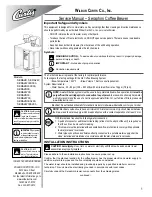
Basic information on electromagnetic compatibility
2.2 Coupling mechanisms
Designing interference-free controllers
8
Function Manual, 06/2014, A5E03461486-AB
2.2
Coupling mechanisms
Depending on the emitting medium and the distance between the source of interference and
the device, interference can reach the automation system via four different coupling
mechanisms.
The following table shows possible causes and typical sources of interference for the various
coupling mechanisms:
Table 2- 1
Coupling mechanisms
Coupling
mechanism
Cause
Typical sources of interference
Galvanic
coupling
Two electric circuits share the same
cable
•
Clocked devices (influence on the
network due to converters and third-
party power supply units)
•
Starting motors
•
Potential differences on component
enclosures with shared power supply
Capacitive
coupling
Potential difference between conductors
•
Interference coupling due to parallel
routing of signal cables
•
Static discharge of the operator
Inductive
coupling
Mutual influencing of current-carrying
conductor loops. The magnetic fields
caused by the current flow induce
interference voltages.
•
Transformers, motors, electrical
welding equipment
•
Power supply cables routed in
parallel
•
Cables whose currents are switched
•
High-frequency signal cables
•
Unwired coils
Radiation
coupling
Effect of an electromagnetic wave on a
cable configuration. This wave induces
currents and voltages.
•
Neighboring transmitters (for
example, walkie-talkies)
•
Spark gaps (spark plugs, collectors
of electrical motors, welding devices)
Summary of Contents for SIMATIC ET 200AL
Page 2: ......
Page 143: ......
Page 218: ......
Page 250: ......
Page 296: ......
Page 337: ......
Page 365: ......
Page 392: ......
Page 419: ......
Page 451: ......
Page 483: ......
Page 597: ......
Page 648: ......
Page 702: ......
Page 739: ......
Page 781: ......
Page 804: ......
Page 828: ......
Page 853: ......
Page 880: ......
Page 906: ......
Page 996: ...Diagnostics ...
Page 1121: ......
Page 1565: ......
















































